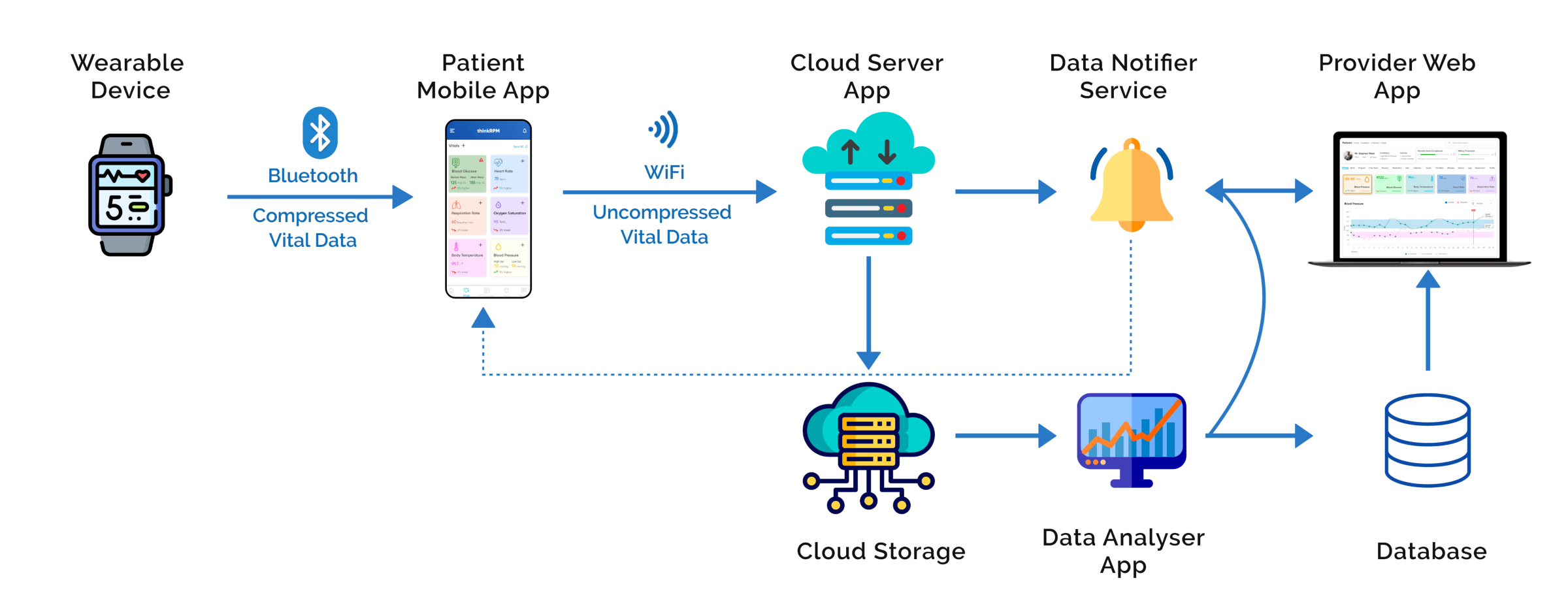Client Requirements
The Client was a US-based Medtech company offering bio-medical sensors integrated with wearable devices like smartwatches. These devices could track a patient's blood pressure, heart rate, ECG, body temperature, falls, steps, and sleep pattern.
The Client wanted to provide enhanced patient care through their devices. It seems to be difficult provide better patient care due to the unavailability of a healthcare professional network and suitable platform.
For that reason Client wanted to develop a custom remote patient monitoring application. Moreover they needed an assistance with add-on device integration capabilities to support their wearable devices.
They wanted to develop an application to enhance their healthcare business by providing better remote care to patients. It involves using their wearable medical devices with continuous patient monitoring by healthcare professionals.
Thinkitive Solution
Our subject matter experts and business analysts collected clients' requirements. Our team is well-versed in everything from middleware platform integration to M2M communications.
Our technical team has expertise in RPM device integration and EHR bridge integration. We assist in connecting with multiple devices and exchange data seamlessly. For wearable Device connectivity, we created a device integration bridge and microservices based architecture integration. We created a custom remote patient monitoring system that collects health data from patients using cellular and wi-fi technology.
We used agile methodology to ensure the software was designed for client feedback and needs. We created wireframes and mockups of the user interface to ensure the Client was satisfied with the design.
Thinkitive built a patient mobile app from the ground up that automatically collects vital data from the smartwatch. Providers and nurses can view vitals and patient data through provider web or tablet apps. Monitoring the data from these connected devices helps assess the Patient's condition quickly and efficiently.
We created a platform for patients & providers that would integrate with their wearable device (smartwatch) & existing electronic health records (EMR).

Solution Highlights
-
Device Integration Bridge
1. Our experts created a bridge. It collects information from devices in various formats and converts it into FHIR APIs. This data can be quickly sent to the RPM platform.
2. Device integration bridge enables the Patient's mobile application and wearable devices to connect and allowing them to exchange data.
3. The bridge supported reliable protocols like HTTP(S), FTP(S), and TCP/IP. The bridge enabled interoperability between the smartwatch and the Patient's mobile application, allowing them to work together to achieve common goals.
4. REST server API collects patients' medical data like blood pressure, spO2, temperature, steps, and sleep patterns.
5. Data was gathered by patients using an application, implemented on a server, stored in a database, and then accessed using an API. Security was ensured, and rules were followed.
-
Patient Mobile Application
We developed a patient mobile application for patients. We have developed a simple UI for checking vitals with one click for super senior people. It takes less than 2 mins to collect vitals. Once data is collected, it is pushed to the provider's platform.
1. Health Data Tracking: Patients can record their vital readings manually using RPM devices. In addition to that, they can connect to wearable devices such as smartwatches etc.
2. Medication Management: Patients can set reminders for taking medications and track medication history.
3. Communication: The Patient mobile application allows patients to communicate with their healthcare providers, ask questions, and receive medical advice. The healthcare provider can also use the application to send messages, check on the Patient's progress, and adjust treatment plans.
4. Emergency Services:An SOS feature sends an alert to emergency contacts and providers in case of a medical emergency.
-
Real-time Patient Health Data Tracking and Analytics
1. Once patients collect their vitals, they are get ready to provider review. A provider can access a patient's health records remotely.
2. The provider can create a customized care program for patients as per the Patient's conditions and assigned devices. Provider can create multiple conditioned based templates.
3. The provider can configure alerts with vital threshold limit as per the Patient's conditions. Alert and notification will be sent to healthcare providers when a patient's vital signs fall outside expected ranges.
4. The Patient can use a smartwatch to collect health data. The system can then set an alert if the vitals exceed the threshold limit. The alert will be sent to providers and caregivers.
5. The provider can see vital trends by selecting appropriate dates. If providers want to add notes for specific vitals, they can send them to the Patient.
-
RPM Integrated with EMR
We provided an EHR Bridge solution to integrate remote patient monitoring, which enables to push and pulled Patient health data seamlessly.
Through Remote patient monitoring, a provider can access patient health information (e.g., diagnoses, test results, chronic conditions) available in EHR.
Value Delivered
The solution was created from scratch and successfully deployed to a client clinic in the United States.
-
End-to-end integrated and homogenous solution for remote management of devices.
-
Scalable Architecture for Device Integration.
-
Reduced Time & Effort with the help of the Device and EHR integration bridge.
-
One-time integration - Single API (Unified API) multiple devices.
-
Each particular Patient has an individual range of standard measurements. A highly customizable system alerts the healthcare manager if the health data exceed the expected ranges.
